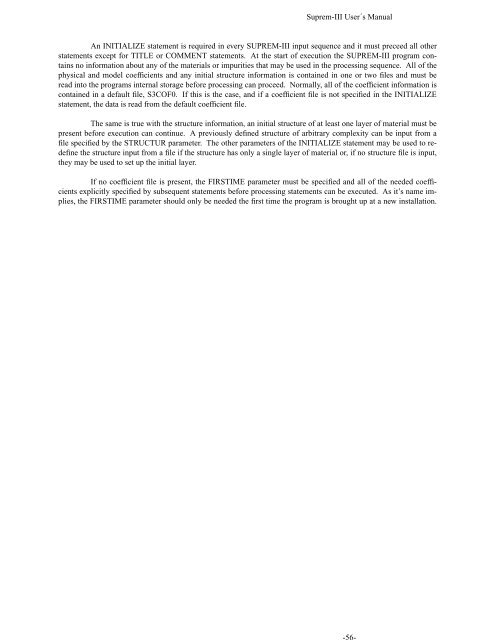Suprem III - Stanford Technology CAD Home Page
Suprem III - Stanford Technology CAD Home Page
Suprem III - Stanford Technology CAD Home Page
You also want an ePaper? Increase the reach of your titles
YUMPU automatically turns print PDFs into web optimized ePapers that Google loves.
-56-<br />
<strong>Suprem</strong>-<strong>III</strong> User´s Manual<br />
An INITIALIZE statement is required in every SUPREM-<strong>III</strong> input sequence and it must preceed all other<br />
statements except for TITLE or COMMENT statements. At the start of execution the SUPREM-<strong>III</strong> program contains<br />
no information about any of the materials or impurities that may be used in the processing sequence. All of the<br />
physical and model coefficients and any initial structure information is contained in one or two files and must be<br />
read into the programs internal storage before processing can proceed. Normally, all of the coefficient information is<br />
contained in a default file, S3COF0. If this is the case, and if a coefficient file is not specified in the INITIALIZE<br />
statement, the data is read from the default coefficient file.<br />
The same is true with the structure information, an initial structure of at least one layer of material must be<br />
present before execution can continue. A previously defined structure of arbitrary complexity can be input from a<br />
file specified by the STRUCTUR parameter. The other parameters of the INITIALIZE statement may be used to redefine<br />
the structure input from a file if the structure has only a single layer of material or, if no structure file is input,<br />
they may be used to set up the initial layer.<br />
If no coefficient file is present, the FIRSTIME parameter must be specified and all of the needed coefficients<br />
explicitly specified by subsequent statements before processing statements can be executed. As it’s name implies,<br />
the FIRSTIME parameter should only be needed the first time the program is brought up at a new installation.















